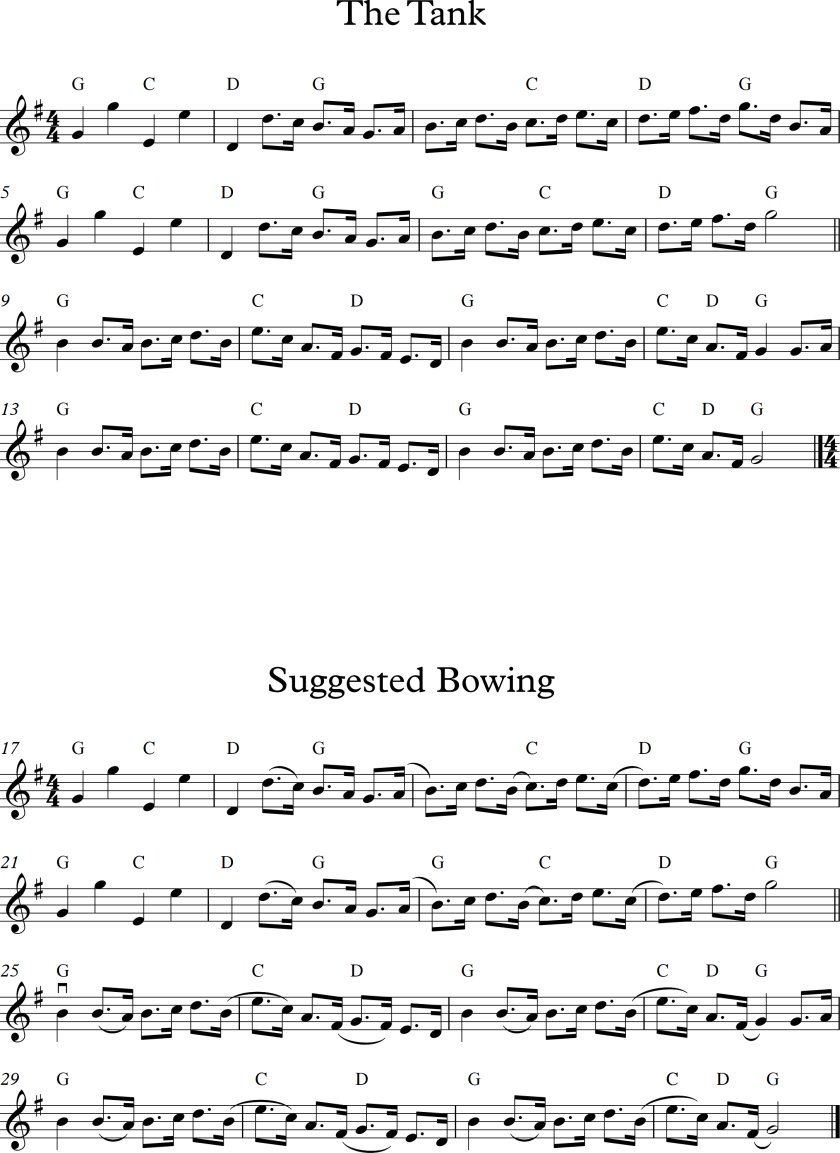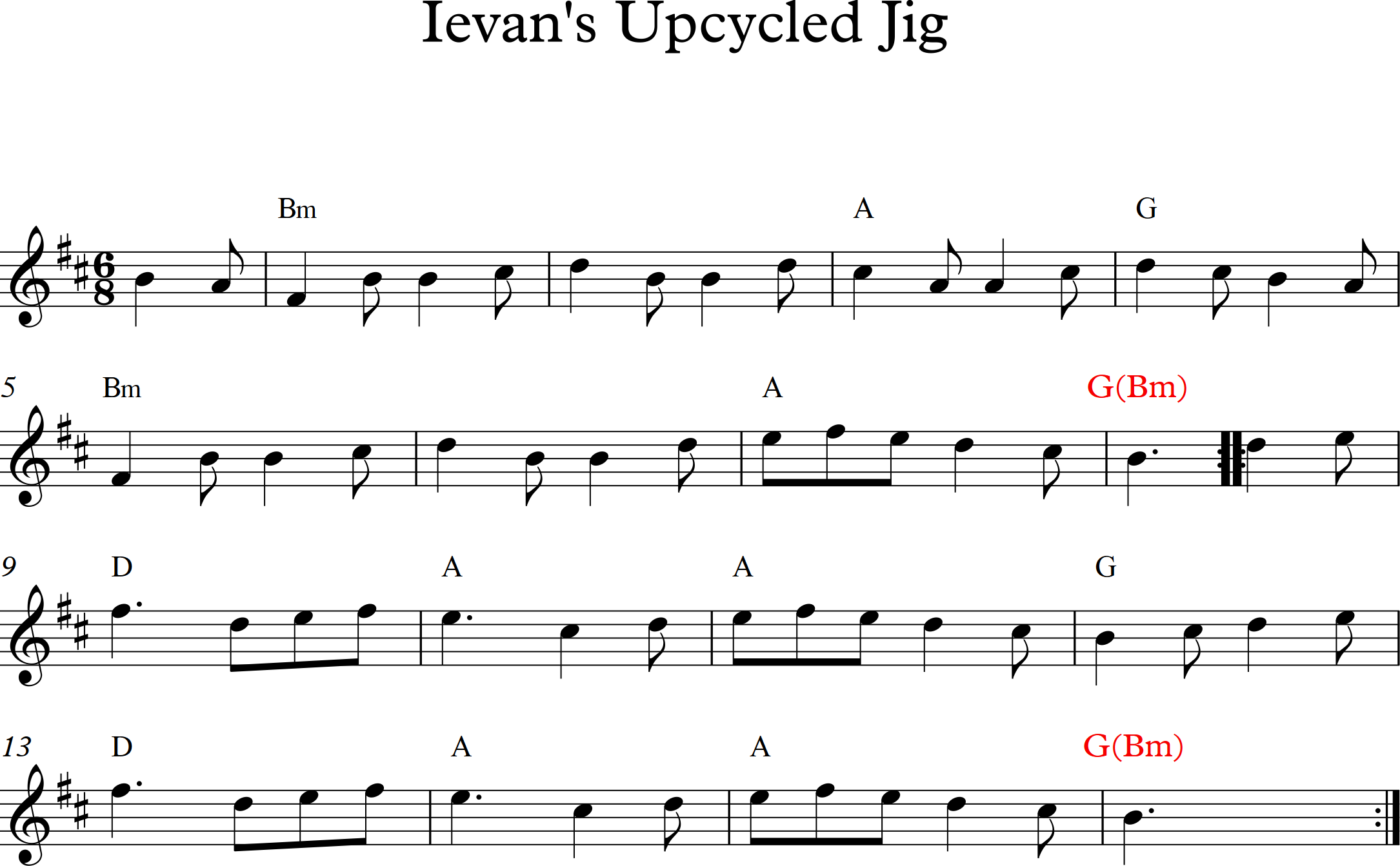Here’s The Tank, an English hornpipe to go with Staffordshire Hornpipe from last week.
Here’s the slower and faster versions:
And the walk though:
Here are the dots with a PDF available here:

Here’s The Tank, an English hornpipe to go with Staffordshire Hornpipe from last week.
Here’s the slower and faster versions:
And the walk though:
Here are the dots with a PDF available here:

Here is the tune from Monday 8th June, the glorious Staffordshire Hornpipe notated from John Locke in 1909 by Cecil Sharp. Here is the slower and faster versions to listen to:
Here’s the walk through:
Here is a video looking at some basic ornamentation and variation:
And finally a video on bowing as there are specific issues for fiddle players in hornpipe tunes!
Lastly, here are the dots, with a PDF available here:

This week we learned a tune called Jack’s Alive, a tune from the 18th century that’s in the English, Scottish and American traditions. This is an English version, but it’s worth looking up others, I recommend folktunefinder.com and https://tunearch.org/ as fairly reliable sources of tunes and, critically, of background information.
Video 1 is a slower and faster play through for you to listen to:
We then have a walk through:
Here are some ideas about about ornamentation:
And a few more about little variations for the tune:
Finally here are the dots, with a PDF available here:

The chord chart with the second chord sequence is available here– these show how you can get stuck in a G -D – G – D pattern if you only stick to the obvious chords, but suggest a route out of this!
This is a tune that came into being last week – I was looking at a tune called Chartley March, but my brain kept pushing me towards the tune I’ve covered here, which is pretty similar. Having played it down the phone to a number of friends, no one could work out what it was, but luckily the hive mind of the class (I think Bob cracked it!) managed to identify it as a jig version of Ievan’s Polkka, which we’ve renamed Ievan’s Upcycled Jig.
Here’s the slow and faster version to listen to before you try learning it:
And here’s the walk through:
Here are videos on ornamentation and on melodic variations:
And finally here are the dots with a PDF here , with a second PDF with possible jig rhythms for chords instruments or for fiddle shuffles (chord shapes are listed in the bonus post below this one).

I also did an Acapella arrangement, with fiddle shuffles and two melody lines to demonstrate the chord rhythms and to show how varying the ornaments and melody doesn’t necessarily create clashes – I tried to make the two parts as different as possible without going overboard, and I didn’t plan anything out before I started so it’s more an example of how the tune might sound in a session – for a concert performance or recording I would probably standardise things a little and definitely arrange the structure more.
Here are some videos talking about how to play accompanying chords on the fiddle, as requested last week. The first two videos are explanations, there are then some hastily drawn chord shapes, and finally some ACapella videos demonstrating the chord sequences and rhythms in context.
Video one – basic chords and rhythms, using Step Back as a reference:
Video Two – slightly more difficult chords and some other things to consider, using Idbury Hill as a reference. Also, I turned the lights on.
Here are some pictures of the chord shapes:
And finally, the shuffle ideas in context:
Here are the videos from Monday 11th session, with apologies for the lateness! Idbury Hill is a Morris tune, from the Fieldtown tradition. The first video is a slow version of the tune – have a good listen before you start to learn or relearn it:
Here’s a walk through of the tune:
Once you’ve got the tune under your fingers, here are some videos on 1. ornamentation and 2. varying the tune:
Finally here’s a video with a play through including ornaments and variation, and a PDF with some of the ideas covered in the above videos.
Here are the dots – click here for a PDF, and a here for a PDF of the two chord sequences we tried.

Monday 4th saw us tackle English Morris tune Step Back. This version is from the Field Town traditional of Leafield in Oxfordshire, and is related to the slightly better known tune/dance Old Molly Oxford. It’s a little unusual for us in that it doesn’t have any repetition of phrases, so I’ve talked a little in the videos about how to learn a tune like this. It seemed like a useful topic to cover right now! I’ll lay out my top tips here too, for brevity and clarity (first time for everything):
Video One is the tune played slowly, followed by the tune a little faster:
Video Two is a walk through of the A section:
Video Three is a walk through of the B section:
Here are dots for the tune with the chord sequence, click here for the PDF:

Here is the from Monday 27th online class, a Swedish tune called Schottis fran Idre – it’s made its way over to some English sessions, and I’m not to pretend that we’re playing it in an authentic Swedish style! The first video is an arrangement of the tune, harmony, chords and bass line – my ukulele is very much out of action at the moment, so I had to substitute my fiddle in, I hope you can still hear the patterns and chords! The second video is a walk through of the tune with a slow version of the tune played through at the end (there is text throughout to help orientate yourself).
Here are the dots for the tune and harmony as taught in the online session, with a PDF available here.

Lastly, if you’ve enjoyed this post, and you’re not a yearly subscriber, please consider making a small donation via the Paypal button below (you don’t need a Paypal account to donate).
We’re starting back today, with an online class followed by detailed walk through videos. Regulars have received an email with log in details – if you’re not on the list but would like to attend please contact me through the site for details.
Hi all, here is the last tune of the term, the Irish slide Star Above the Garter. Since we’ve played some tunes from Kerry over the last few weeks, in our warm ups and as a main tune, it seemed appropriate to stay in that general area! There’ll be a bit of a break now until mid-April during which I’ll experiment with different formats, structures, subscriptions and technologies since it’s currently looking like we won’t be able to meet in person for some time. Please assume that online content will replace meetings until further notice.
Again these videos are supposed to be a substitute for our group sessions, so if you’re not a yearly subscriber and have enjoyed this post, please consider making a small donation via Paypal (you don’t need a Paypal account to donate). Enjoy, and I’ll be in touch soon!
The PDF of the basic tune is available here, but I would really recommend relying on your memory and relearning the tune from the video as and when you forget it – each subsequent time you learn the tune from the video, you will pick it up faster and will be a little more likely to retain it over time. If you rely on the sheet music then you’re not practising remembering the tune!
Next, here’s a video with bowings and ornaments, with a PDF (including a harmony and bass line) available here.
Last but not least we have a video of the tune, harmony, chords and bass line together – the harmony part is high in the mix, but I’m since I’ve not recorded it anywhere else I’ve decided to leave it as is!